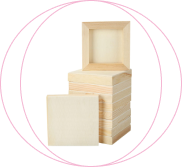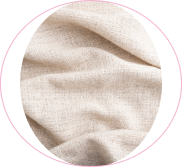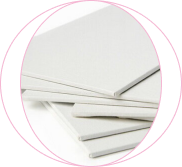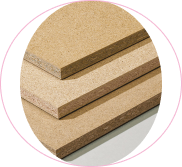Oil painting is widely popular, and many famous artists created their works using oil paints. Of course, you can’t learn to work with oil paints in one day; it is a diligent and painstaking process. But if you put in the effort, the results will not keep you waiting.
Here are some practical tips for beginner artists on how to choose a surface for oil painting and whether it needs to be primed.
Bases (surfaces) for oil painting
Oil painting is a fascinating art form that requires not only talent but also an understanding of the basic aspects of surface preparation for creativity.
Let’s start with the choice of the base itself. An artist can use various materials — canvas, cardboard, wood, or even metal. Each material has its own characteristics that affect the nature of the work. Canvas is considered a classic choice due to its flexibility and durability.
 Canvas
Canvas
Canvas is one of the most popular materials among artists. Its textile base provides stability and the ability to work with large-format paintings. For convenience, the canvas is stretched on a frame.
 Wooden Panel
Wooden Panel
A wooden panel is the choice for those who prefer a harder surface. It provides excellent paint adhesion and resistance to deformation. Wood gives the work a warm feel.
 Metal Surface
Metal Surface
An unusual but interesting option is a metal surface. It highlights the brightness of colors and creates a shiny effect. Metal is often used in modern and abstract works, adding a metallic tint and light play.
 Textile
Textile
Textile surfaces offer the artist a wealth of textures and patterns. Linen or cotton bases add a special touch to the work. Textile emphasizes naturalness and brings a certain lightness to the painting.
 Primed Paper
Primed Paper
Primed paper is for those who prefer a lighter and more flexible base. It is an ideal option for sketches, drafts, and works in the “alla prima” technique. The smooth surface of the paper ensures good paint distribution.
 MDF (Medium Density Fiberboard)
MDF (Medium Density Fiberboard)
MDF provides the artist with a stable and smooth base. It is not prone to deformation from moisture or temperature changes. The material allows for creating detailed and meticulously crafted works.
The choice of a suitable surface depends on the artist’s individual preferences and the nature of their work. One can experiment and find the perfect surface that suits them best.
Pros and cons of oil painting surfaces
Features of surfaces for oil painting:
Oil paints reveal their magnificent nature on various surfaces. Canvas, wood, cardboard — each material adds something unique, a certain highlight to the artwork.
- A properly prepared surface becomes a reliable foundation for the future artwork. It prevents sagging and deformation, ensuring the longevity of your creation.
- From smooth panels to rough canvases, the choice of surface opens the doors for artistic experiments. It is like a journey where each new surface is a new stage of your creativity.
Canvas:
- A traditional choice for most artists.
- Absorbs oil well, creating deep and rich colors.
- Has a pleasant texture.
- Can be prone to deformation over time.
- Requires preparation before starting work (e.g., applying primer).
- May develop oil stains and yellowing over time.


Wooden Panels:
- Resistant to deformation and sagging.
- Do not require priming, simplifying preparation.
- Suitable for fine details and delicate work.
- Limited in size.
- Can be heavy compared to other surfaces.
- Often require an additional layer of primer to prevent oil absorption.
Aluminum Panels:
- Resistant to deformation and humidity.
- Lightweight and durable.
- Create bright and clear colors.
- More expensive compared to other materials.
- Require special primer for better adhesion.
Linen Canvas:
- Provides an excellent surface for fine work.
- Absorbs oil well.
- Requires preliminary preparation.
- Can be prone to deformation when exposed to humidity.
- May develop cracks over time.

For those who prefer more flexible options, canvas attached to cardboard is much more suitable. It ensures ease and mobility in work, allowing for experimentation with composition and angles.
And linen canvas is simply considered a classic choice in the field of oil painting. Its texture provides the best surface where the paints lie softly and naturally.
In the art of oil painting, there is no universal solution for choosing a surface. Each one offers unique opportunities and challenges. It is important to choose the material considering your preferences and the style you work in.
Strive for harmony between idea and tools, and your art will be a delightful embodiment of your creative ideas.
Recommendations for choosing a basis for painting
Choosing the right base for painting is quite a task. Here are some interesting recommendations:
Canvas:
- Ideal for oil paints: canvas absorbs oil paints excellently, creating rich and durable colors.
- Variety of textures: the choice of canvas texture (smooth, medium, or rough) allows the artist to work with unique artistic effects.


Wooden Panel:
- Resistance to deformation: wood is a stable material that prevents canvas deformation over time.
- Great for details: ideal for fine and detailed work.
Primed Paper:
- Lightweight and portable: paper is usually light and easy to carry, making it a great choice for traveling artists.
- Experimentation with techniques: primed paper is suitable for various techniques: watercolor or mixed media.
Textile:
- Textural possibilities: textile provides unique opportunities for creating textures and three-dimensional effects.
- Unusual shapes: artworks on textile always offer the chance to experiment with unusual shapes and structures.
Aluminum Panels:
- Modern look: aluminum panels give paintings a modern and stylish appearance, adding a metallic shine and smoothness.
- Resistance to deformation: aluminum has high resistance to deformation, making panels an excellent choice for works requiring a stable surface.
Seek inspiration from each of these bases; only through trial and error can you find the best option.

Canvas on a stretcher: a classic base for oil painting
In art, every painting is not just a combination of colors on a canvas but the embodiment of the artist’s creative inspiration. However, before the brush makes its first stroke, a magnificent painting begins with the choice of the right base.
One of the classic and best-performing bases for oil painting is the stretched canvas. Let’s focus on this material and discuss it in detail.
Memories of great masters, visionaries, and creators of beautiful works of art are often associated with this magical material.
One of the greatest advantages of stretched canvas is its strength and durability. Thanks to the frame made of wooden ribs, the canvas becomes incredibly strong and resistant to deformation. The artist can be calm and confident that their painting will last for decades, retaining its original beauty.
Another incredibly important aspect of stretched canvas is its texture and ability to convey every brushstroke. The smooth surface of the canvas will give the work shine and clarity, while the characteristic texture will create a play of light and shadow, making the artwork lively and rich.
Stretched canvas is not just a tool but a part of the creative process itself. The combination of high-quality material and the artist’s virtuosity results in an ordinary canvas becoming a space where great ideas are born. Your ideas.
Finally
The base for oil painting is the foundation upon which the magnificent building of creativity is constructed. The choice is vast: canvas, wood, metal, and more.
I advise you to try each of the surfaces, get personally acquainted with all the advantages and disadvantages of each base. Don’t limit yourself — try everything and you will find the perfect ally in your creativity!
Question-answer
Yes, before starting work with oil paints, it is recommended to prime the canvas. The primer creates an even and durable base on the canvas surface for applying oil paints, preventing the canvas from absorbing the oil and ensuring better adhesion of the paints.
There are different types of primers: acrylic, acrylic-oil, oil, etc. The choice of primer depends on your preferences and style of work. To create a smoother surface, some artists may use several layers of primer, sanding it between each application layer.
Also, if you are using a pre-stretched canvas, it may already be pre-primed. In this case, check whether the type of primer meets your needs, and if necessary, add additional layers of primer.
The canvas for painting is primed with a primer, which serves several important functions.
Firstly, it strengthens the surface of the canvas, making it more resistant to mechanical impacts.
Secondly, the primer creates an even base for applying paints, preventing their absorption or spreading. Various substances can be added to the primer to alter the texture of the canvas and give the artwork additional artistic features.
This is a kind of preparation to ensure that every brushstroke is realized in the best possible way on the canvas.
The choice of canvas primer material is an important decision. Gypsum most often acts as the main material for this purpose and has already become a kind of standard in the world of primers. Easily available in art stores, plaster is characterized by its white color and pleasing texture, which gives the canvas a distinctive look.
- Cleaning the canvas: make sure the canvas is free from dust and dirt. If necessary, wash it and let it dry thoroughly.
- Priming: cover the canvas with a primer for oil paints. Primer is usually a mixture of gypsum, chalk, and glue. You can buy pre-made primer at an art supply store or make it yourself by adding water and glue to gypsum or chalk powder.
- Applying the primer: use a brush or roller to apply the primer evenly to the canvas. Typically, several layers are applied, with each layer allowed to dry before the next is applied.
- Sanding: once the primer is dry, you can proceed to sand the surface of the canvas. This helps to create a smooth surface for painting.
- Preparing for painting: wait until the primer is completely dry and the surface is smooth; the canvas is now ready for oil painting.
1. Canvas Preparation::
- If the canvas is new, smooth it out to remove wrinkles and creases.
- If the canvas is used, ensure it is clean and dry.
2. Applying the Primer:
- Use a primer for oil painting, which can be purchased at art supply stores.
- Apply the primer in a thin layer using a brush or roller.
- Spread the primer evenly over the surface of the canvas.
3. Smoothing the Primer:
- Smooth the primer with a flat brush or spatula to avoid unevenness and create a smooth surface.
4. Drying:
- Allow the primer to fully dry according to the instructions on the packaging. This usually takes a few hours or days, depending on the type of primer.
5. Repeating the Process (optional):
- If necessary, repeat the process to create a more durable surface.
Sanding (optional):
- After complete drying, you can lightly sand the primer for a smoother surface.
Starting Painting: After priming, you are ready to begin oil painting.




